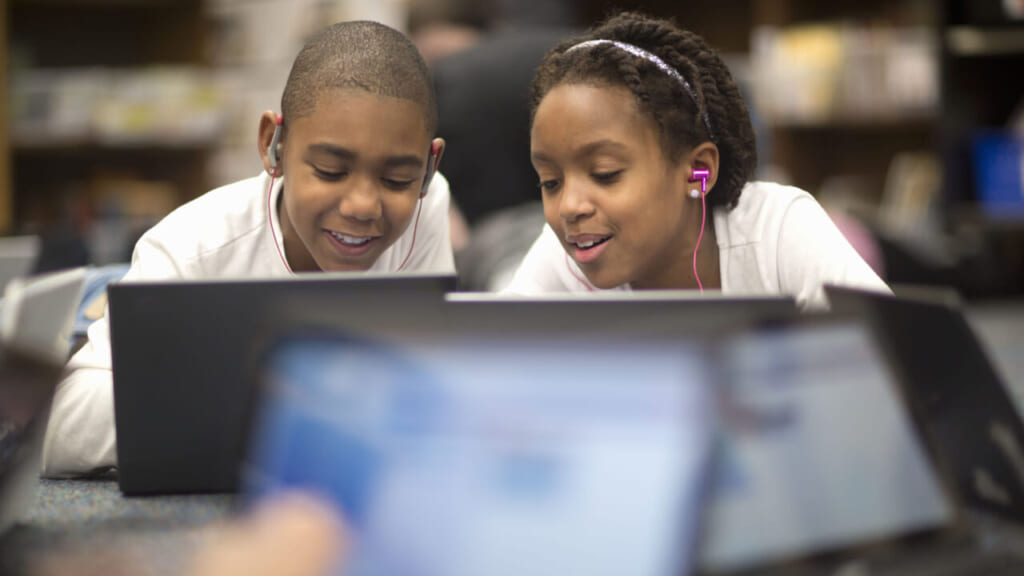How much screen time is too much for your kids?
OPINION: One of the biggest challenges parents face today is figuring out how to balance the pros of keeping children engaged with the technology they will inevitably need in the future with the cons of potential health effects on brain development, mental health and social behavior.

Editor’s note: The following article is an op-ed, and the views expressed are the author’s own. Read more opinions on theGrio.
Today’s children are surrounded by digital technology—smartphones, tablets and laptops mean the internet is more portable and easily accessible than ever, making it almost unfathomable to imagine a world without it.
A report from Common Sense Media found that nearly half of all children 8 and under have their own tablet device and spend an average of about 2.25 hours a day on digital screens.
As the world becomes increasingly media-saturated and technology-dependent, today’s parents are the first generation tasked with figuring out how to manage their children’s screen time, balancing the pros of keeping them engaged with the technology they will inevitably use in their future careers with the cons of the short-term and potentially long term health effects it may have on brain development, mental health, and social behavior.
Since 1999, public health organizations have basically told the public to keep screen time to a minimum, or no time at all, if you are an infant or toddler. The World Health Organization (WHO) and the American Academy of Pediatrics (AAP) recommend no screen time at all for children until 18 to 24 months, except for video chatting, and for one hour or less of screen time per day for kids ages 2 to 5. Parents have taken heed of this advice but have found it nearly impossible to gauge their child’s screen time once they start school.
More recent studies have called these recommendations into question. Admittedly, the science behind the WHO and AAP screen-time guidelines has major limitations—-they are based on correlational, cross-sectional or self-report studies—a far cry from the longitudinal, randomized control trial studies that are the gold standard for determining the cause and effect of behavior and its outcome; researchers have yet to determine the optimal amount of screen time or exactly how much screen time is too much screen time.
According to research conducted by the American Academy of Child and Adolescent Psychiatry, infants who spend the most time engaging with a screen are more likely to exhibit signs of impulsiveness, have shorter attention spans, show less empathy and produce lower test scores compared to those who spend less time on their iPads, phones and tablets.
Elementary school-age children who watch TV or use a computer more than two hours per day are more likely to have emotional, social and attention problems; and in teens and adults, excessive screen time is associated with a laundry list of health problems, including eye strain, eye fatigue, sleep problems, chronic neck and back problems, obesity, poor self-image and body image issues, depression and anxiety. Even more, exposure to violent TV shows, movies, music, and video games has been associated with deferred imitation—desensitization towards and mimicry of violence to solve problems. Put simply, children are more likely to imitate the violent behavior they see on TV when exposed to violent images.
There’s no doubt that the rise of digital media consumption and the globalization of academic and employment opportunities have contributed to negative health trends like cyberbullying and more sedentary lifestyles, but technology isn’t all bad.

The positive effects of technology on children range from learning how to multitask to developing new ways of creative expression and problem-solving. A 2019 study from the University of Oxford in London found that screen time in moderation actually seems to have a positive impact on kids—the researchers reported higher levels of social and emotional well-being in children with one to two hours of screen time versus those who reported no screen time—countering the blanket bans of many public health organizations. Additionally, smartphones and social media are often used as tools to create “real-life” social connections. Adults connect with one another through blogs, book clubs and support groups; toddlers learn through animations on YouTube and watch them together on playdates; teens play video games together, and people text one another so that they can meet up.
So what’s the deal? Is technology good or bad? And if it’s somewhere in the middle, how do you strike a balance between digital and “real life” activities so your children are using these powerful digital tools responsibly?
No one seems to have an answer, but completely eliminating technology from our lives does not seem to be the most realistic or effective approach. Multigrain bread is good for you, but too much bread might not be. Sleeping is also good, but sleeping all day, not so much. I think we’d all agree that eliminating multigrain bread from our diet and sleep from our daily routine would not be a wise thing to do. The same logic can be applied to managing the amount of time we spend on electronic devices. Finding a healthy balance between tech and non-tech activities requires that parents work with their children to find what works best for them. It also helps to model this balance in our own lives and show our youth the value of forming memories with family and friends without the need for digital activities.
There’s no single recipe for success. The goal is to teach children how to use technology in a healthy way—avoiding the extremes of excessive use that turn a good thing bad. Simply banning or severely restricting access to smartphones denies our children the opportunity to become successful digital citizens. It may also result in the unintended consequence of abuse later on in life—think the significant increase in alcohol consumption after an initial decrease in drinking during the prohibition era. A rebound effect is common when any activity is categorically prohibited, therefore setting responsible limitations tends to yield more long-lasting results.
Limiting screen time is only as good as the activities that replace them. Reading, puzzling, playing board games, attending a live sporting or music event and hanging out with friends are immeasurably important to positive intellectual and social development. Instituting protected no-screen times bolstered by rules, such as no phones at the dinner table, can encourage familial bonding time; and charging your electronic devices outside of your room so you aren’t tempted to use them at night or first thing in the morning can create a healthy detachment from technology.
The influence of digital engagement on our lives is real, but learning how to balance technology and life shields us from its negative impacts on our health. Early studies from the National Institutes of Health on brain development and screen time seem to support the idea of limiting screen time early in life, but ultimately teaching our children how to use it wisely later in life discourages the type of digital abuse that limits future success and hinders good health.

Dr. Shamard Charles is the executive director of graduate studies in public health at St. Francis College and sits on the Medical Advisory Board of Verywell Health (Dot Dash-Meredith). He is also host of the health podcast, Heart Over Hype. He received his medical degree from the Warren Alpert Medical School of Brown University and his Masters of Public Health from Harvard’s T.H. Chan School of Public Health. Previously, he spent three years as senior health journalist for NBC News and served as a Global Press Fellow for the United Nations Foundation. You can follow him on Instagram @askdrcharles or Twitter @DrCharles_NBC.
TheGrio is FREE on your TV via Apple TV, Amazon Fire, Roku, and Android TV. Please download theGrio mobile apps today!


